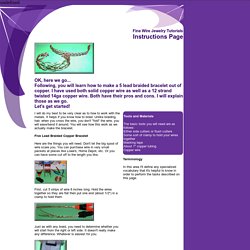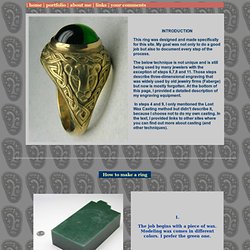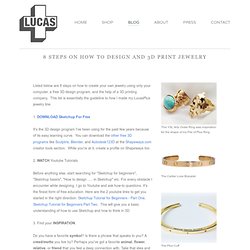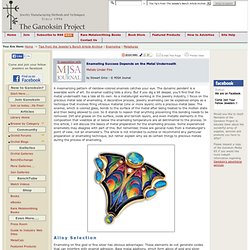Zoom
Trash

Craft Tools - Hobby Tools. Jewellery Training Solutions. Jewellery Training Solutions.
Kilns. Jewelry Tools. The International Guild of Wire Jewelry Artists - edu_Tut_DanishKnot. Instructions Page. I will do my best to be very clear as to how to work with the metals.

It helps if you know how to braid. Unlike braiding hair, when you cross the wire, you don't "fold" the wire, you will ease/bend it around. You will see how this work as we actually make the bracelet. Five Lead Braided Copper Bracelet Here are the things you will need. First, cut 5 strips of wire 8 inches long. Just as with any braid, you need to determine whether you will start from the right or left side. When you use 5 leads, it is simply a matter of "Over and Under. " Then you take the outside lead on the other side (5,4) and bring in over the lead next to it (4) and under the middle lead again. Braid sort of loosly. Just below, following the exact same steps, are pictures of solid copper wire. Remember: OVER AND UNDER, OVER AND UNDER. Hardware Store Bracelet.
Jewellery Making Useful Websites. Jewellery Making Materials. Enamelling. Electroforming & etching. Jewelry Making Meetups near London, England - Meetup. Wirework. Jewelry Making Courses. Jewelry Making Tutorials. Beading. Jewelry Making Suppliers. Engraving With a Microscope. This is a set of gravers that I use for engraving and making models.

Gravers #1, # 2, #3 and #4 are flat gravers. #5 and #6 are round gravers. #7, #8, #9, #10and #11 are wedge gravers. Some of the gravers are straight, others are beveled. Straight gravers can mostly be used on convex surfaces but not on flat or concave surfaces; beveled gravers can be used on convex, flat or slightly concave surfaces. Graver #4 is both beveled and bent and can cut on any (convex, flat or concave) surface. George Goehl, Since 1973.
The Spoon Jeweler - Home. How 2 Use A Miter Jig. Aim Redstone Deal - London-wide: Amazon Local.
8 Steps On How To Design And 3D Print Jewelry — LucasPlus Jewelry by Lucas Goossens. Listed below are 8 steps on how to create your own jewelry using only your computer, a free 3D design program, and the help of a 3D printing company.

This list is essentially the guideline to how I made my LucasPlus jewelry line. 1. DOWNLOAD Sketchup For Free It's the 3D design program I've been using for the past few years because of its easy learning curve. You can download the other free 3D programs like Sculptris, Blender, and Autodesk123D at the Shapeways.com creator tools section. 2. Before anything else, start searching for "Sketchup for beginners", "Sketchup basics", "How to design ..... in Sketchup" etc. 3.
Do you have a favorite symbol? The most important thing is to have fun. When first opening Sketchup, it'll ask you what template you want to work in, whether you want to work in large scale like meters, or smaller scale inches and millimeters. When you feel that your 3D model is ready to become a finished product to be shared with the masses, take nice photos of it! View earrings by TaylorsEclectic. Home. Brain Press Publications. Metals Under Fire - Enameling success depends on the metal underneath. A mesmerizing pattern of rainbow-colored enamels catches your eye.

The dynamic pendant is a wearable work of art. Its enamel coating tells a story. But if you dig a bit deeper, you'll find that the metal underneath has a tale all its own. As a metallurgist working in the jewelry industry, I focus on the precious metal side of enameling. A decorative process, jewelry enameling can be explained simply as a technique that involves firing vitreous material (one or more layers) onto a precious metal base.
Alloy Selection Enameling on fine gold or fine silver has obvious advantages: These elements do not generate oxides that can interfere with enamel adhesion. Rose Chemicals Ltd. [Jewelry making - Article 00079] - Re: [Orchid] Tricks on dealing with fire-scale. Firescale » Juxtamorph » United Artworks. A: Pripp’s flux will do it.

Pripp’s flux is a mix you make up yourself, and it works pretty much the same as a borax coat, which is the older and more traditional method. Classical silversmiths would often go through several sequences of “burning on” a borax coat before annealing or soldering, but it doesn’t work quite as easily or as well as Pripp’s. I’ve been a gold and silversmith since college, and learned Pripp’s from Prof. Fred Fenster at the University of Wisconsin, who proclaimed in that 1972 sophomore class that at other schools people sometimes complained about firescale, but “here at U.W. it never gives us a problem”.
This, by the way, was taught from the first moment we were shown how to light a torch, just to give you an idea of how important and basic a technique Fred felt it was.